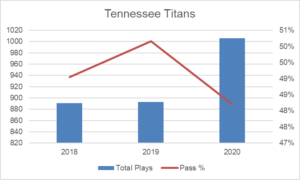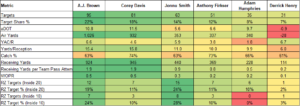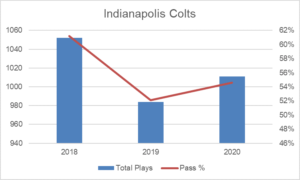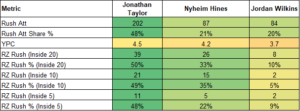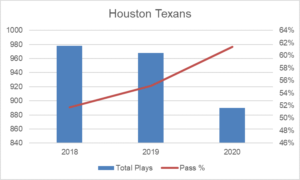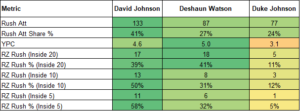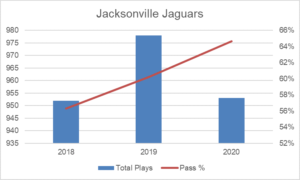Those who have followed my writing throughout the 2020 season will know that I’m a projections guy, I released weekly content highlighting key facts and stats about play volume, pass/rush tendencies, Vegas lines, target leaders, etc – my Projections Retrospective.
Now that 2020 has drawn to a close, I’ll be spending some time reviewing the total season numbers. The goal, to be more informed about what each team did so we can better project how they’ll tackle 2021 (subject of course to coaching and personnel changes over the offseason).
If you missed it, check out my Projections Guide where I looked at some of the key league-wide numbers for 2020 and stepped through how to create your own projections.
Let’s dive in to the AFC South.
Tennessee Titans
In 2018 and 2019, Tennessee were bottom three in total plays with less than 900 offensive plays. In 2020 they jumped above 1,000 plays. There’s no clear and obvious driver for this change so I’m going to call it regression. As a division-winning team, you’d expect them to dominate and run more offensive plays, with 1,000 plays around the middle of the pack.
This is a very concentrated passing attack with AJ Brown and Corey Davis taking all the good stuff. Their totals are close to each other but they got there in slightly different ways. Brown cemented his reputation as the YAC (yards after catch) monster where Davis was the safe hands catching 74-percent of his targets despite an aDOT (average depth of target) over 11.
If you looked at the numbers alone, you’ll see a lot of similarities with Cleveland with 77-percent of air yards going to the wide receivers on only 56-percent of targets. The tight ends were much more involved in the red zone though, accounting for almost half of targets inside the 10.
There’s not too much to talk about here, it’s the Derrick Henry show. Although there were a smattering of games throughout the season where they gave him a bit of a rest and let others shoulder some of the load.
The one interesting insight here is the red zone usage. Through weeks 1 to 9, Henry got 100-percent of attempts inside the 5 yard line and all but two carries inside the 10 (92-percent). From week 10 onwards, he dropped to 45-percent of rush attempts inside the 5 and 41-percent inside the 10. I wouldn’t take too much from it however, with four of those ‘inside the 10’ attempts coming from Darrynton Evans in a week 15 blowout.
Key Takeaway: This team has a clear identity and that should provide some predictability for 2021. It’s a heavy-run scheme with short area targets to tight ends and big plays to Brown and Davis.
Indianapolis Colts
Following Andrew Luck’s retirement, the Colts went from one of the highest play totals in the league in to the bottom half. In 2020, with a new Quarterback and time to gameplan for him, they bounced back up around league average. Their passing ratio has also been reflective of their ability to run the ball behind a strong offensive line over the past couple of seasons.
This one is interesting. I noted above how Tennessee and Cleveland give a little over 50-percent of their targets to their wide receivers but well over 70-percent of the air yards, with a very specific gameplan to run the ball more than they pass. Well despite having a higher pass ratio, Indianapolis have the same profile of targets and air yards. What’s different here though, is that its the running backs who get the next largest share of targets thanks in no small part to Nyheim Hines being second only to TY Hilton (which is another great example of not all targets being equal – look at the difference in air yards between Hilton and Hines).
Marcus Johnson made his hay in the middle of the season when Hilton was struggling, there’s too many tight ends to make any of them useful, and they spread the ball far and wide in the red zone.
I’m sure we remember Taylor’s struggles in the middle of the season but it was book-ended by good market share and that middle part of the year paints a negative picture on the whole season story.
Similarly, there were parts of the season where Taylor missed out in the red zone, particularly inside the 10, but he re-gained that role at the end of the season and set himself up nicely for 2021 in the process.
Key Takeaway: Indianapolis have a clear desire to run the ball whenever the gamescript allows them to. If they can get themselves in more of those situations then we could see a Tennessee/Cleveland style of play, the Colts are just a lot more willing to lean on the pass when they have to.
Houston Texans
It was the lowest offensive play volume in the league and the only one less than 900 plays. What happened? Their record did. They went from a 10 or 11 win team who ran the ball nearly half the time and put together drives, to a losing team throwing over 60-percent of the time and an average time of possession of only 27 minutes per game. If they make the right moves in the offseason (NOT trading away Deshaun Watson) then I’d expect this to bounce back in 2021.
A story of what could have been for Will Fuller. It was a tandem approach for him and Cooks but signs all point to Fuller as the 1a before his suspension. Cobb was a strong third option before he missed time at the end of the year. The red zone targets look like an even distribution on the face of it but when you scratch the surface you find that Cooks has six of his seven targets in three games, and it was Akins, Coutee and the running backs in the back half of the season.
It’s a concentrated rush attack but there’s not much to go around for the Johnsons as Watson takes his fair share. Over 70-percent of Duke’s rush attempts were when David was sidelined, a period where Watson’s share also increased to compensate. Not much going at the goal-line either, with over 80-percent of David’s goal-line attempts coming in just three games.
Key Takeaway: Houston fits their approach around their talent and doesn’t force it to the guys who aren’t good enough. With Hopkins gone it was a tandem receiving attack, and when David Johnson got injured they didn’t force feed Duke. All change in Houston and I can see this offense looking very different in 2021.
Jacksonville Jaguars
2019 looks to be a recent outlier for Jacksonville (perhaps bouyed by the Minstache) as 2020 saw a dip back to their 2018 levels of bottom five across the league. Unsurprisingly, their passing ratio has increased year on year as they consistently found themselves in negative gamescripts.
It’s no surprise that there wasn’t much production in this offense and we can see a clear lack of dominant receiver across the board. Perhaps one of the most stand-out numbers here is the aDOT (average depth of target) of Laviska Shenault. He was very much a short target with low air yards and a reliance on YAC (yards after catch). Shenault came in to the league with a versatile skillset and a reputation as a swiss-army knife, but this desire to be creative with him seems to have prevented any usage as a traditional receiver and severely impacted his volume.
One of the most concentrated rush attacks all season, there’s really not too much to dig in to here. Robinson’s red zone usage was good but the Jaguars didn’t get down there too often. There’s also a notable difference with the different Quarterbacks, as Minshew provided some production on the ground while Glennon stayed put.




